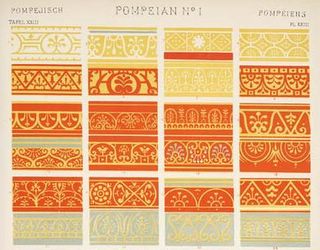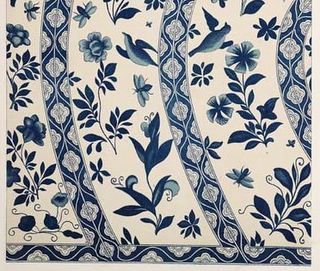
Sunday, October 30, 2005
Thursday, October 13, 2005
Indian textile designs
4to40 Indian children's portal offers a huge coloring book library of Indian textile designs.
Scroll down on the activities page.

Scroll down on the activities page.

Tuesday, October 11, 2005
Tuesday, October 04, 2005
Owen Jones 1809-1874
From the University of Wisonsin Digital Library for the Decorative Arts and Material Culture.
Full facsimiles of The Grammar of Ornament (1856) and Examples of Chinese ornament selected from objects in the South Kensington Museum and other collections (1867).
Jones, an architect and ornamental designer who served as superintendent of works at the Great Exhibition of 1851, was instrumental in the application of chromolithography to book illustration. In his travels as a young man he became fascinated by Eastern forms, and the books he published reproducing these patterns influenced the design of English wallpaper, carpets, and furniture.
The Grammar of Ornament, one of the masterpieces of nineteenth-century color printing, is a systematic presentation of ornamental motifs from the ancient world through the Renaissance. There are several thousand examples; each plate depicts a group with common chronological and geographical origins. The individual plates, lithographed by Francis Bedford, are tied together by a unified color scheme. As the title suggests, Jones intended the work to be used as a practical guide and resource for designers, and the introduction includes a set of principles covering "the arrangement of form and color."
The Grammar of Ornament. 1856

Examples of Chinese ornament selected from objects in the South Kensington Museum and other collections. 1867

The color plates are offered in 4 resolutions. If you want to print them choose the largest page size to save. Look for this tool.

Full facsimiles of The Grammar of Ornament (1856) and Examples of Chinese ornament selected from objects in the South Kensington Museum and other collections (1867).
Jones, an architect and ornamental designer who served as superintendent of works at the Great Exhibition of 1851, was instrumental in the application of chromolithography to book illustration. In his travels as a young man he became fascinated by Eastern forms, and the books he published reproducing these patterns influenced the design of English wallpaper, carpets, and furniture.
The Grammar of Ornament, one of the masterpieces of nineteenth-century color printing, is a systematic presentation of ornamental motifs from the ancient world through the Renaissance. There are several thousand examples; each plate depicts a group with common chronological and geographical origins. The individual plates, lithographed by Francis Bedford, are tied together by a unified color scheme. As the title suggests, Jones intended the work to be used as a practical guide and resource for designers, and the introduction includes a set of principles covering "the arrangement of form and color."
The Grammar of Ornament. 1856

Examples of Chinese ornament selected from objects in the South Kensington Museum and other collections. 1867

The color plates are offered in 4 resolutions. If you want to print them choose the largest page size to save. Look for this tool.

Monday, October 03, 2005
Origami Tessellation freeware
My favorite new toy is Tess, an origami tesselation program generously shared by Eric Gjerde .
This little program does not install but runs in Windows ( I have XP home) from a gui.exe.
Do download the Documentation PDF but don't freak out like I did when I read the install instructions...they mention perl etc. The section after that is about running it from the gui which is so easy. Just click the gui.exe and Tess opens.
The patterns can be saved as postscript files which I opened with Illustrator. I've just begun playing but think that this will be useful for paper and quilting projects. Do visit the homepage and check out the gallery.
This is my first Tess.

I'm so happy! It's been a long time since I've found a fun, free art tool.
This little program does not install but runs in Windows ( I have XP home) from a gui.exe.
Do download the Documentation PDF but don't freak out like I did when I read the install instructions...they mention perl etc. The section after that is about running it from the gui which is so easy. Just click the gui.exe and Tess opens.
The patterns can be saved as postscript files which I opened with Illustrator. I've just begun playing but think that this will be useful for paper and quilting projects. Do visit the homepage and check out the gallery.
This is my first Tess.

I'm so happy! It's been a long time since I've found a fun, free art tool.






